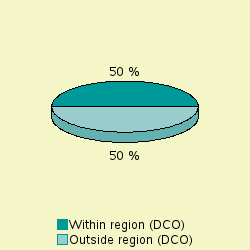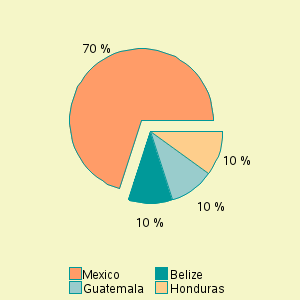Transfers of ICE Detainees from the
Yavapai County Juvenile Detention Center
Camp Verde, Arizona
Detainees Transferred Number last 12 months 10 Out of total detained 10 Facility ranking on transfers top 98 %
Table 1: TransfersDuring the most recent 12 month period for which data are available, a total of 10 detainees were transferred by Immigration and Customs Enforcement (ICE) from the Yavapai County Juvenile Detention Center where they had been temporarily housed to other facilities. The average stay for these individuals before their transfer was one day. This is a special facility for housing juveniles.
Transfers made up 100 percent of the 10 detainees who in one way or another left this facility during the last 12 months. This report focuses just on these transfers.
This report series is based upon analyses conducted by the Transactional Records Access Clearinghouse (TRAC) at Syracuse University of 1.7 million government records tracking each individual who passed through an ICE detention facility during fiscal year 2015. This most recent 12 month period for which comprehensive data are available covers October 2014 through September 2015. See About the Data.
How This Facility Ranks Nationally
Detainee transfer rankings. The Yavapai County Juvenile Detention Center was one of 637 facilities nationwide that housed ICE detainees during the most recent 12 month period. Of these 637, there were 409 facilities that had at least 10 ICE detainee transfers last year. Excluding those facilities with fewer than 10 transfers, the Yavapai County Juvenile Detention Center last year ranked in the top 98 percent nationwide in the number of individuals it transferred to other ICE facilities. This means that this facility was at the very bottom of those facilities that were ranked since it only had 10 transfers.
Average length of stay before transfer. Once detainees arrived at the Yavapai County Juvenile Detention Center their average length of stay before being transferred on to another ICE facility was one day last year. Ranking facilities from longest to shortest detention stays for their transfer population, this average of one day placed Yavapai County Juvenile Detention Center in the top 71 percent of all facilities nationwide. That is, for detainees who are transferred, 71 percent of ICE detention facilities have the same or longer average stays last year, while 29 percent of detention facilities had shorter average stays.
Origins and Destinations
Were these detainees arrested locally? Where did those that ended up being transferred from the Yavapai County Juvenile Detention Center last year originate? Information on the place of arrest was not included in the available data ICE released. However, we can examine whether the Yavapai County Juvenile Detention Center was the first ICE facility in which these detainees were held. According to ICE records, for some (20 percent) of these detainees, the Yavapai County Juvenile Detention Center was the first place they were sent when they were detained by ICE. The remaining 80 percent had been transferred in from another ICE detention facility.
We can also look at how quickly they arrived at this facility after they were first detained. A total of 40 percent arrived at the Yavapai County Juvenile Detention Center at some point during the very first day they were detained by ICE. This percentage is also based on an analysis of the most recent 12 months for which data are available.
How soon did transfers occur? Nationally, the median number of days before an ICE detainee is transferred to another facility was 1 days last year. That means that half of all transfers occurred on or before the 1st day, while half had longer stays before they were transferred on to another ICE facility. Note that nationally the average stay at an ICE detention facility before an individual is transferred is longer - 12 days. This is because while most detainees have relatively short stays before ICE transfers them elsewhere, sometimes stays are lengthy and these lengthy stays raise the average to above the median stay.
For the Yavapai County Juvenile Detention Center last year, the median stay before a detainee was transferred was one day. This is the same as the national figure. The average stay before transfers occurred was the same - one day - than the median stay. As noted above, this figure placed the facility in the top 71 percent among ICE detention facilities nationwide in the average number of days a detainee spent before he or she was transferred.
Where did those transferred get sent? ICE currently has great discretion about where in the United States transferred detainees are sent. For the period covered by these data, ICE divided the country into geographic regions or areas and assigned each to one of 152 document control offices or DCOs for the purpose of keeping track of detainees. Available data allow us to examine whether the transfer occurred within the same DCO or the transfer was to a different DCO. For the nation as a whole during the latest 12 months, 54 percent were within the same DCO, while the remaining 46 percent were to a different DCO.
Transfers Facility Profile U.S Overall
Profile (%)Number Percent Within region (DCO) 5 50% 54% Outside region (DCO) 5 50% 46% Total 10 100% 100%
Table 3: Transfer destinations during last 12 months
Figure 2 and accompanying Table 3 provide some comparative figures for how the Yavapai County Juvenile Detention Center stacks up against this national pattern. Last year, 50 percent of the transfers from the Yavapai County Juvenile Detention Center were to locations in the same region -- facilities under the control of same ICE docket control office. The majority (50 percent) of the transfers went to detention facilities in a different region (DCO).
Nationalities
Which nationalities predominate? Last year in the United States, individuals from Mexico comprised the largest number of those transferred by ICE. Some 41.3 percent of all transfers recorded Mexico as their country of origin. The Yavapai County Juvenile Detention Center had a much larger proportion of detainees from Mexico - 70 percent - among their transfers. Detainees from Mexico were also the largest single nationality group among the transfers at the facility.
In descending order, the top nationalities that made up transfers from the Yavapai County Juvenile Detention Center last year were: Mexico (70%) , Belize (10%), Guatemala (10%) and Honduras (10%).
Nationalities Ranked in Top 10 Transfers Total To Diff. DCO % Diff DCO - ALL 10 5 50.0 % 1 Mexico 7 2 28.6 % 2 Belize 1 1 100.0 % Guatemala 1 1 100.0 % Honduras 1 1 100.0 %
Table 4: Transfers by nationality
during the last 12 months
Out-of-region transfers by nationality. Within the nationalities that made up those listed in Table 4, the proportion transferred out of the region varied from 29 percent to 100 percent. As mentioned above, on average 50 percent of detainees transferred from the Yavapai County Juvenile Detention Center were sent to detention locations outside the region.
More than one country was tied with the highest out-of-region transfer rates of 100 percent (see Table 4). At the other end of the range, 29 percent were out-of-region transfers for the 7 transfers from Mexico.


